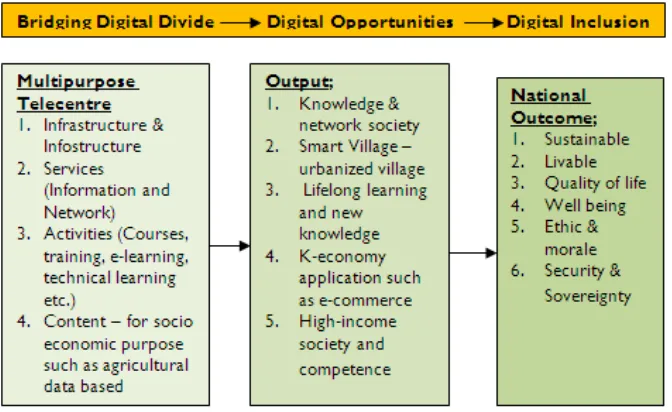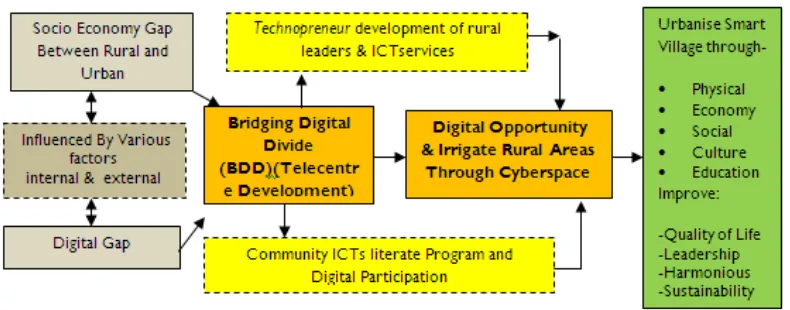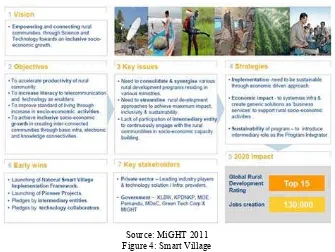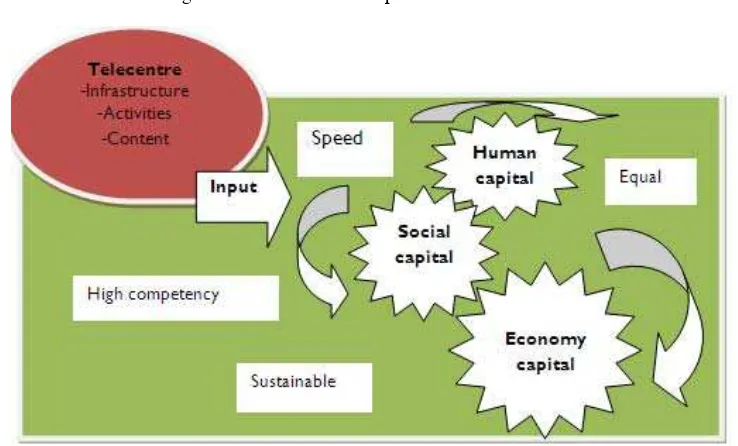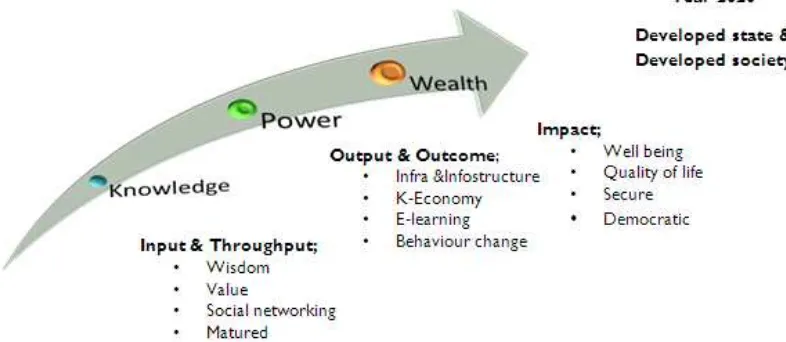SYMBIOTIC RELATIONSHIP BETWEEN TELECENTRE AND LIFELONG
LEARNING FOR RURAL COMMUNITY DEVELOPMENT: A MALAYSIAN
EXPERIENCE
Jalaluddin Abdul Malek
E-Community Research Centres, Faculty of Social Sciences and Humanities, Universiti Kebangsaan Malaysia, UKM Bangi, Selangor, Malaysia
jbam@ukm.my
Abdul Razaq Ahmad
Faculty of Education, Universiti Kebangsaan Malaysia, UKM Bangi, Selangor, Malaysia razaq@ukm.my
Mohd Mahzan Awang
Faculty of Education, Universiti Kebangsaan Malaysia, UKM Bangi, Selangor, Malaysia mahzan@ukm.my
Alfitri
Faculty of Social and Political Sciences, University of Srivijaya, Indonesia al_fitri2002@yahoo.com
ABSTRACT
Telecentres in the 21st century may be able to improve standard of living, quality of life, and stability of knowledge for the rural population. The role of telecentres is widely increasing in developing political and management awareness, economic, socio-culture, technology, education and regulation awareness in rural communities. Telecentres in this context is a premise or a centre of information and communications technology (ICT) for rural residents to obtain information and knowledge. The major role of telecentre is to bridge the digital divide and socio-economic gap between rural and urban population. Telecentre is also a centre of lifelong learning activities for the rural population to seek formal and informal knowledge. This paper is intended to demonstrate the development of telecentre experiences in Malaysia that focuses on scholarly activities through lifelong learning of the rural population. The scope of discussion depicts the seven routes of informal symbiosis between lifelong learning with the telecentres that gave positive impact on rural development in Malaysia. The discussion is based on the discourse and experience of telecentre development in Malaysia.
Keywords: Telecentres, Lifelong Learning, Rural Population
1. INTRODUCTION
Historically telecentre was known as Telecottage in Sweden, in Denmark's Electronic Village Halls, and Community Technology Centres in the USA. In the cities, it works like a cyber café and information kiosks but differ in terms of goals and operation. Telecenter is a specifically built premise to provide facilities of ICT literacy, information, and knowledge to the rural population (Parkinson 2005). It is also the centre of training for the development of ICT for marginalized rural population such as the poor, women, children, disabled, elderly, indigenous people, SMME and youth. The key role of a telecentre is to bridge the digital gap between urban and rural areas. In other countries, it is known as Cyberdhabas telecentres in India, Cybercefes in Latin America, Vishva Gnana Kendra in Sri Lanka and Net Cafes, Internet cafe or WARNET in Indonesia (Aalami & Pal 2005).
Copyright © The Turkish Online Journal of Educational Technology 2. TELECENTRES IN MALAYSIA AND LIFELONG LEARNING
Community Broadband Centre (CBC) is a telecentre that stimulate lifelong learning in Malaysia. It is one of the projects implemented under the Universal Service Provision Program (USP) by the MCMC. To date, there are 168 CBC established in the country under the supervision of Telekom Malaysia (TM). In general, the objective of the CBC is bridging the digital gap between rural and urban communities. Among the lifelong learning in CBC are basic computer introduction courses, basic courses for the Internet and electronic applications, desktop publishing such as Microsoft Office. The next Telecentre is Village Info Square (Medan Info Desa @ MID). It is a public telecentre run by an appointed telecentre manager and equipped with ICT infrastructure and focuses on the development of ICT for rural communities. MID is also a centre for circulating information and a catalyst to bridge the digital gap through a lifelong learning such as e-commerce entrepreneurship training and ICT skills. People's Information Centre or Pusat Maklumat Rakyat (PMR) is a telecentre that offer ICT services in each district office and it is free. PMR is the result of National Information Council or Majlis Penerangan Kebangsaan (MPK) Bill. 1/2005 on February 28, 2005 meeting. Although PMR has no specific program but there arelifelong learning for the community such as dissemination of information about government policies, and as a centre of online information.
Community Broadband Library (CBL) is the government's efforts to bridge the digital gap between rural and urban population. It also aims to develop ICT literate human capital and high quality IT entrepreneurs. CBL is a lifelong learning centre, originally known as the village library. MCMC in collaboration with Telekom Malaysia Berhad (TM) is upgrading several libraries in rural areas to become CBLs, equipped with computer and internet connection. CBL lifelong learning facilities such as ICT-related learning activities, computers, connection to the internet, and facilities for printing, scanning and copying.
Rural Internet Centre (PID) has been launched and implemented in 2000 with an initial amount of 14 pilot sites selected across the country. The main objective of PID program is to bridge the digital gap between urban and rural areas through the provision of ICT infrastructure and the provision of free training to rural communities. By 2003, 42 PID was built in post offices throughout Malaysia. The function of PID has been enhanced as Community Knowledge Centre and a one-stop centre for e-Government, e-learning, communication centre, test centre and skills training courses with certification.
3. SYMBIOTIC SUSTAINABILITY OF TELECENTRE AND LIFELONG LEARNING
The United Nations (UN) recognised the role of telecentres to empower rural development in particular through lifelong learning based ICT projects for development (ICT4D). Lifelong learning means that all activities undertaken in the form of learning to meet the needs of human life (World Bank 2003). Its main purpose is to improve formal and informal knowledge, to enhance the skills and competencies of the human person in terms of career, social, ethical, and civic as well as thought. Lifelong education telecentres are made formal and informal so that rural people can adapt to current changes, and can be active in the field of socio-economic development. Among the lifelong learning program held in the telecentres are formal learning such as courses, vocational and technical skill certification organized by higher learning institutions. Non-formal learning, such as survival skills and learning between the generations, for example, parents learn to use ICT with their children, or children learn how to play computer games with friends. Lifelong learning in telecentres has been bridging the digital divide and knowledge gaps among Malaysians. Statistics by MCMC in quarter of 2012 showed broadband penetration rate is 62.9 per cent of Malaysia's population. Similarly, the cellular phone ownership is in the ratio of 128.7 per 100 populations in Malaysia. Statistical year 2009 also showed 35.1 households in Malaysia own a personal computer (MCMC 2012).
The four basic sustainability of symbiosis telecentres are very important as a basis for development of telecentre as a centre for lifelong learning. Based on the four types of symbiosis, the development of telecentres as a centre for lifelong learning can be achieved based on seven routes symbiosis.
Figure 1: Sustainability of Symbiosis Telecentre and Knowledge
Symbiosis 1: Centre for Social Knowledge Engineering Village Community.
Various functions of telecentres progress can be realised when the development is in symbiosis with social, physical and spiritual aspects. Telecentres not only act as a centre of ICT facilities, but also a social science engineering centre that include the development of the rural community of thought, body and spirit. From the social point of view, telecentres develop communication networks, networks of knowledge and networked society. Telecentres as social science engineering centre is also developing the physical aspects of the population, especially to support K-economic progress and development of a knowledge society (Figure 2). This symbiosis can realise the implementation of the K-economy and create a society that is capable of producing new knowledge in all areas for national development (Elkington, Hartigan & Schwab 2008).
From the aspect of thought and knowledge, telecentre serves as a centre of spiritual education to rural communities. Islamic Da'wah, including engaging the community with integrity and ethical teaching can be done. Campaigns fostering moral values in society, particularly rural communities are abound on the internet. In this regard, many websites on the field of Islam is preaching. Users only need to choose website in accordance with the Islamic faith and topics of interest wisely. (Zulkiple Abd Ghani, 2010). Maturity of thinking, physical, and spirit of rural communities with ICT in the telecentre for continuous learning can facilitate the process of achieving national development agenda.
Figure 2: Telecentre and Social Knowledge Engineering
Symbiosis 2: Urbanise the village through cyberspace education.
Copyright © The Turkish Online Journal of Educational Technology
development was undertaken by the Government. Traditional village that has the potential to be developed are being upgraded as a Rural Growth Centres (PPD). PPD is the final stage of growth centres that offer such services in the cities.
The advancement of ICT technology and the support of the government through taxation of ICT and sponsored public ICT programs has helped fuel the development of the rural urbanisation approach. ‘One computer per household’ and the ‘rural telecentre projects’ are sample programs that tries to connect the village to the cyberspace. Cyberspace refers to a virtual space that is used to surf the internet for obtaining information and knowledge (Figure 3). Cyberspace is also a fast knowledge stream regardless of space and times. Cyberspace also means that knowledge can be accessed in the same place same time, same place different time, another place at another time and another place and time (ESCAP, 2006).
Directions of various functions of telecentre development direction as shown in Figure 3 requires appropriate methods and approaches to spur the link between the village and the cyberspace. In 2012, the Malaysian government targets to upgrade telecentre as Rural Transformation Centre (RTC) and a catalyst for smart village development. The effect of this drive is the transformation from rural communities to smart rural community (Malaysia 2002). The digital opportunity and success of urbanising `village through cyberspace knowledge', depends on the attitude and co-operation of the rural population as outlined in the Development Vision Policy (Malaysia 2001).
Symbiosis 3: Developing knowledgeable Smart Village.
In the year 2010 and later, the development of telecentres in Malaysia has a greater role in addition to developing information structure services and infrastructure. Telecentres are considered as an important facility that can realise the emergence of a smart village. MID under MRRD has been upgraded as Mini Rural Transformation Centre or Mini-RTC. Among the roles of Mini-RTC are as a business, marketing and entrepreneurial centre. Mini-RTC in a smart village also serves as a centre of education and continuous learning in the field of vocational and technical skills to rural youth.
Figure 3: Praxiology of Urbanising Rural Areas through Cyberspace
Source: MiGHT 2011 Figure 4: Smart Village
Symbiosis 4: Developing E-Commerce and E-Industrial Knowledgeable Community throughout life. Sustainability of telecentre is symbiotic with social programs and social business enterprise (Figure 5). The evolution of telecentres must be able to meet the needs of the rural society and in turn enhance rural entrepreneurship. Telecentre is a cyber business premise that provides a social service to the rural population. Social service efforts of telecentres are called social business and social enterprise. Telecentres may produce innovative and creative entrepreneurs in the social field, particularly among telecentres business managers. (Mankani, 2003).
Social business and social enterprise is a business that aims to focus on social objectives rather than profit. Type of business and social forms of social enterprise business can be likened to legal bureau services, counselling centres, micro-credit as Grameen Bank project, and recycling business through telecentres (Yunus 2007). Figure 5 shows the influence social business and social enterprise on e-Commerce) and e-Industrial lifelong knowledge Community in rural areas.
Figure 5: Social Business and Social Enterprise in Telecenters
Symbiosis 5: Realising E-Development and Reconciliation based on knowledgeable society.
Copyright © The Turkish Online Journal of Educational Technology
When e-development and reconciliation is in symbiosis with the role of telecentres, the benefits can be seen either at the macro, meso and micro level (Figure 6). At the macro level, telecentres plays an active role in national development vision. At the meso level, they enables the implementation of e-government systems, the K-economy and knowledge society based on civil society. At the micro level, the impact of improved quality of life, safety and welfare of households, particularly the target rural population who are isolated. Continuous learning activities through the government portal access at telecentres are able to foster the spirit of progress among the rural population. Rural communities are able to make adjustment to be able to be an advanced knowledge society with the disclosure of information, knowledge of the internet and continuing education in the rural areas.
Symbiosis 6: Strengthening the Identity of Knowledgeable Nation in Rural Areas.
There are limited platforms in the past to develop self-reliance and developing nations. Telecentre role as a centre of lifelong learning can be in symbiosis with activities to strengthen the development of knowledgeable people who have a sense of identity, love people, and love of country. The focus is through programs that enhances human capital, social capital and thus increase economic capital (Figure 7).
Figure 6: Sustainable Development and Reconciliation
Figure 7: The Development of Identity for Knowledgeable Nation (Human Capital and Social Capital)
Training and skills whether it is non-academic or vocational skills in the telecentres can accelerate progress on human, social and economic capital in rural communities, particularly the youth. Awareness programs and the advancement of literacy like 1Malaysia transformation campaign can be accessed directly via a computer web site at the telecentre. Indirectly, human capital can be nurtured to produce individuals who have the skills and integrity. Furthermore, social capital can be enhanced through rural communities because they have a wide range of network and communications globally for the use of internet facilities at the telecentre. Through this continuous network, the rural communities in long-term will get the latest information and knowledge to enhance their progress. Automatically, the outcome of human capital strength and social capital will eventually strengthen the rural economy.
Figure 8: The Curve Progressive of Knowledgeable and Advanced Community
Symbiosis 7: Expedite the Presence of Knowledgeable Society in rural areas.
Integrating telecentres with lifelong learning may accelerate the existence of a society that has the advantage of knowledge, power, and wealth. Knowledge, power, and wealth in the form of material and non-material are important factors for a country;s development in this postmodern era. Accession to the digital age and the use of telecentres interpreted through the concept of community participation in the process of continuous learning in the telecentre. Active participation of digital community is a democratic and contributed society. They can create new sources of wealth and useful knowledge on an ongoing basis. This community is capable of thinking, creativity, and innovation and wise. In the end they form power either in the form of physical power, economic, social, cultural, and/or political power (Figure 8).
Democratic society is a civil society whom has the power to influence their own living environment. They have independent thought, but a structured, high quality of life and live a sustainable competitive environment. Security and sovereignty is secure even when they are exposed to the cyberspace that has no borders. This community is able to create wealth whether the wealth in the form of physical, spiritual and knowledge. Democratic society who uses telecentres has high knowledge effect of continuous learning program. They become catalyists for a country’s development.. They are obsessed with the achievement of material alone, but also with non-material progress. As a result, this lifelong learning society reaches the peak to become a developed nation and developed society respected in the international arena (Figure 8).
CONCLUSION
Copyright © The Turkish Online Journal of Educational Technology REFERENCES
Aalami, J. R. & Pal, J. 2005. Rural telecenters Impact Assessments and the political economy of development of ICT. Berkeley Rountable on the International Economy. University of California, Berkely. Paper BRIEWP164.
Douglas, A. 2010. The Symbiotic Habit. Princeton: Princeton University Press.
Economic and Social Commission for Asia and the Pacific (ESCAP), United Nations. 2006. Guidebook on Developing Community e-centers in rural areas: Based on the Malaysian experience. New York: ESCAP, United Nations.
Elkington, J., Hartigan, P. & Schwab, K. 2008. The power of unreasonable people: How Social Entrepreneurs create markets that change the world. Massachusetts, USA: Harvard Business School Publishing. Longworth, N. 2001. Learning communities for a learning century. In Aspin, D. at al (eds.). International
Handbook of Lifelong Learning, p: 569-590. Dordecht, The Natherlands: Kluwer.
Longworth, N. 2006. Learning cities, learning regions, learning communities. London: Routledge.
Malaysia. 2001. The third outline perspective plan 2001-2010. Kuala Lumpur: National Printing Malaysia Bhd. Malaysia. 2002. Knowledge-based economy master plan. Kuala Lumpur: Institute of Strategic and International
Studies (ISIS).
Mankani, D. 2003. Technopreneurship: The successful entrepreneur in the new economy. Singapore: Pearson. Malaysia-Industry Innovation Group for High Technology (MIGHT). 2011. Beyond innovation: intensifying
sustainable and balanced growth based on innovation-led economy. New York: MIGHT.
Malaysian Communications and Multimedia Commission (MCMC). 2012. Communication and multimedia pocket books of statistics. Cyberjaya, Selangor: MCMC.
Parkinson, S. 2005. Telecentres, access and development. Ottawa, Canada: International Development Research Centre.
Saffo, M.B. 1993. Coming to terms with a field: Words and concepts in symbiosis, Symbiosis,14: 1-3.
Wan Mohamad Nor Wan Daud. 2001. Development in Malaysia: Towards a new understanding of a better life. Kuala Lumpur: Academy of Islamic Studies, University of Malaya.
World Bank. 2003. Lifelong learning in the global knowledge economy: challenges for Developing Countries (directions in development). Washington, D.C.: World Bank Pub.
Yunus, M. 2007. Creating a world without poverty: Social business and future of capitalism. New York: Public Affairs.
